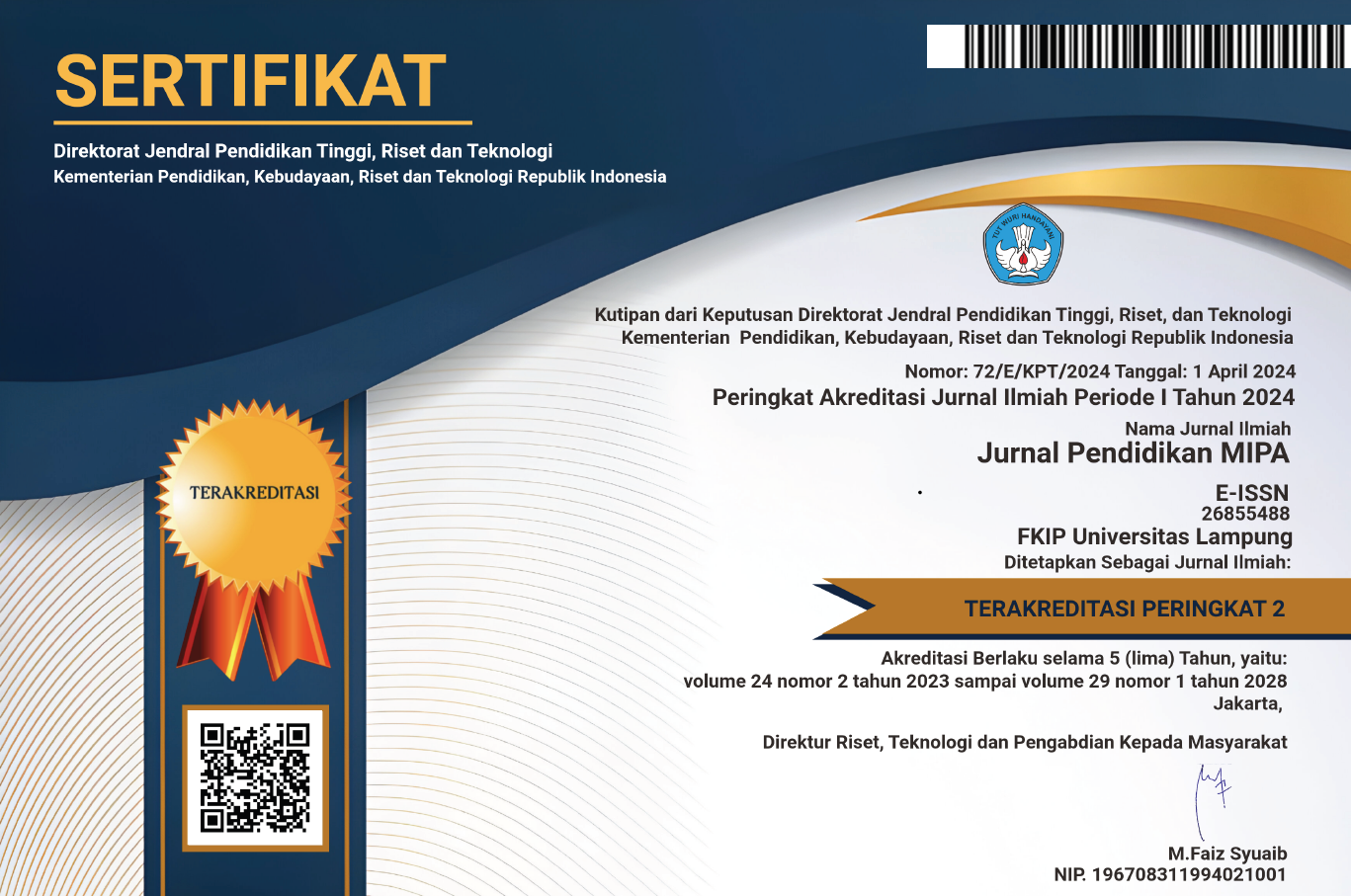Development of Science Literacy-Based Cognitive E-Assessments on Chemical Bonds
 Country:
Country:
(1) Universitas Lampung, Indonesia
(2) Universitas Lampung, Indonesia
(3) Universitas Lampung, Indonesia
(4) Universitas Lampung, Indonesia
This study aims to develop scientific literacy-based cognitive e-assessments on chemical bonds and describe the validity, teacher responses, and student responses to the developed e-assessment. The research design used in this study was a research and development (R&D) design according to Gall, Borg, & Gall (1996). The instruments used in this study were expert validation questionnaires, teacher response questionnaires, and student response questionnaires. The data obtained from validators, teachers, and students were then analyzed by descriptive statistical analysis method. This scientific literacy-based cognitive e-assessment uses 4 aspects of scientific literacy, namely aspects about the knowledge needed for intelligent participation in science-based social problems, aspects about the ability to think critically about science and dealing with scientific expertise, aspects about understanding science and its applications, and aspects about understanding science and its applications. knowledge of the risks and benefits of science. This e-assessment was created to measure students' scientific literacy. The results of expert validation and teacher responses on aspects of content suitability, construction aspects, and readability aspects indicate a very feasible category. The results of student responses on the construction aspect and the readability aspect showed the criteria were very feasible. Thus, the scientific literacy-based cognitive E-assessment on the chemical bonding material developed can be said to be valid and feasible to use.
Keywords: cognitive e-assessment, chemical bonding, scientific literacy.
Anggraini, G. (2014). Analisis kemampuan literasi sains siswa SMA kelas X di Kota Solok. Jurnal Prosiding Mathematics and Science Forum 2014. Jurusan Biologi FPMIPA: Universitas Pendidikan Indonesia.
Bergqvist, A., & Rundgren, S. N. C. (2017). The influence of textbooks on teachers’ knowledge of chemical bonding representations relative to students’ difficulties understanding. Research in Science & Technological Education, 35(2), 215–237.
Beschorner, B., & Hutchison, A. (2013). iPads as a literacy teaching tool in early childhood. International Journal of Education in Mathematics, Science and Technology, 1(1), 16–24. https://lib.dr.iastate.edu/edu_pubs/26/
Bybee, R. W. (1997). Achieving scientific literacy: From purposes to practices. Westport, CT: Heinemann.
Chang, S. N., & Chiu, M. H. (2005). The development of authentic assessment to investigate ninth graders’ scientific literacy: In the case of scientific cognitive concerning the concepts of chemistry and physics. International Journal of Science and Mathematics Education, 3, 117–140.
Eymur, G., & Geban, Ö. (2017). The collaboration of cooperative learning and conceptual change: Enhancing the students’ understanding of chemical bonding concepts. International Journal of Science and Mathematics Education, 15(5), 853–871.
Gall, M. D., Borg, W. R., & Gall, J. P. (1996). Educational Research: An Introduction. New York: Longman Publishing.
Leu, D. J., Jr., Kinzer, C. K., Coiro, J., & Cammack, D. W. (2004). Toward a theory of new literacies emerging from the Internet and other information and communication technologies. In R. B. Ruddell & N. Unrau (Eds.), Theoretical Models and Processes of Reading (5th ed., pp. 1570–1613). Newark: International Reading Association. Diunduh 26 Maret 2009 dari www.readingonline.org/newliteracies/lit_index.asp?HREF=leu/
Mueller, J. (2005). The authentic assessment toolbox: Enhancing student learning through online faculty development. North Central College, 1(1), 1–7.
Nahum, T. L., Mamlok‐Naaman, R., Hofstein, A., & Taber, K. S. (2010). Teaching and learning the concept of chemical bonding. Studies in Science Education, 46(2), 179–207.
Özmen, H. (2004). Some student misconceptions in chemistry: A literature review of chemical bonding. Journal of Science Education and Technology, 13(2), 147–159.
Toharudin, U. (2011). Membangun Literasi Sains Peserta Didik. Bandung: Humaniora.
Tsaparlis, G., Pappa, E. T., & Byers, B. (2018). Teaching and learning chemical bonding: Research-based evidence for misconceptions and conceptual difficulties experienced by students in upper secondary schools and the effect of an enriched text. Chemistry Education Research and Practice, 19(4), 1253–1269.
Refbacks
- There are currently no refbacks.

This work is licensed under a Creative Commons Attribution-ShareAlike 4.0 International License.






